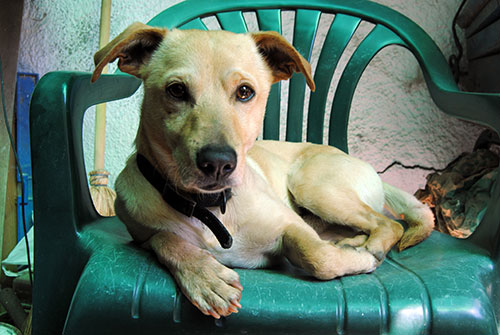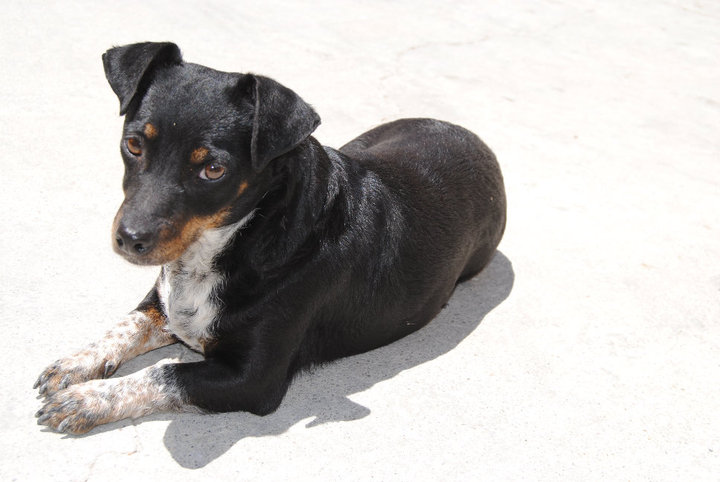Animal Care and Behaviour: Dogs
Canine Social Cognition

See also:
- Learning from Dogs and Wolves
- Behavioural Problems
- Finding a Good Training Class
- Multi-dog households: Enjoying life with more than one dog
- Designing a dog Garden
- Books about canine evolution and wolves
- Books: Breed profiles and breed books
- Books: General books about dogs
- Books: Health and nutrition
- Books: Puppy training and good manners
- Books: Behaviour and training philosophies
Part 1: Dogs are special
Dogs are a unique species
Dogs are unique as a species in being able to bond closely with humans, despite living with conspecifics (others of their species). Dogs just need minimal exposure to humans by the age of 9-14 weeks (1). Wolves, on the other hand, can only bond with humans if they are separated from conspecifics before their eyes are open, and to develop a bond, they need a lot more contact with humans than dogs do (2).
Dogs are geared for a partnership with us, and this potential to bond can be 'switched on' with surprisingly little contact, just a few minutes a day. Without this minimal contact before 14 weeks, dogs are extremely wary of humans, and have to be tamed as though they were a wild species (3). Contact makes bonding possible. Bonding gives dogs the motivation to learn how to decipher humans and understand our social rules. Right from the start, dogs learn to communicate with their owners, their mother and their littermates. Later, they meet strange humans and dogs. They learn the meanings of a wide range of human vocalizations and body language, from coos of adoration and gentle strokes, to angry shouts and waving arms.
Humans are obsessed with language. True, it's useful, we can teach dogs to find objects by name, like 'keys' or 'mobile' - handy if you've lost them. Verbal encouragement helps dogs find objects. Sometimes canine intelligence is assessed in terms of how many human words a dog understands. Border collies, for example, can learn a surprising number of words for objects, and can also categorize them (4). Some dogs have a wide range of expressive vocalizations, while others are taciturn. Curiously, even non-dog owners can distinguish between the bark of a lonely dog, and that of a dog alerting to a stranger (5). This ability to understand barks seems to be built into humans. However, we aren't as good at understanding canine body language as we are at interpreting their barks, and children often misinterpret canine signals (6).
Dogs tend to be much better at understanding our body language than we are at understanding theirs. They look at us for cues, like pointing, or the direction we're looking in. Dogs from any breed can do this, in spite of the variations between breeds in levels of ability. Wolves, however, are less likely to look at humans than are dogs, especially when trying to solve a problem, a key difference between wolves and dogs (7). Dogs get around our deficiencies by doing whatever works. Some sit on their owners' laps when it's walk time. Others take their leashes to their owners, or stand by the door and look hopeful. It's worth keeping a diary to record which of your non-verbal signals your dog is picking up, and how your dog tries to communicate with you.
In addition to understanding humans, dogs also learn to communicate with one another. This isn't always easy. We've created breeds of dogs which often communicate in different ways. Spitz dogs tend to be expressive. Their body language is easy to 'read', while other breeds may be much less expressive. There's potential for misunderstanding when a dog first meets another with a different 'body dialect'. Yet most dogs which have the chance to meet a wide range of breeds come to understand them well. In this potential to accept strangers, even those who are different from us, dogs are more like humans than wolves, which tend to be intolerant of strange wolves on their territory (8).

Dogs can also learn social rules, both human social rules (like 'don't jump on strangers') and canine social rules (like 'don't jump on bad-tempered arthritic dogs'). The process of learning social rules is called 'socialization', and as Miklosi remarks, dogs are unique as a species in going through a double socialization process, 'A puppy is expected to learn the rules of social life of dogs, as well as many of those of the human community' (9). A fully socialized dog is socially competent in both human and canine societies.
Read more: Canine Social Cognition, part 1: Dogs are special
Part 2: Differences between dogs
This article first appeared in Norwegian, Danish and Swedish, in Canis magazine, August 2014
Village dogs in Rural Spain

Dogs can learn enough of our social rules to live in harmony with us, though the specific rules a dog needs to learn depend on the norms of the human society the dog lives in.
When we first arrived, I built a gate as a barrier to stop the dogs from going upstairs to a balcony, where they could get access to the roof. 'Will that work as a barrier?' I asked the village friend who helped me build it. 'It wouldn't work for my dogs, because they're smart and street-wise. But your dogs aren't as clever', she answered.
Read more: Canine Social Cognition, part 2: Differences between dogs

